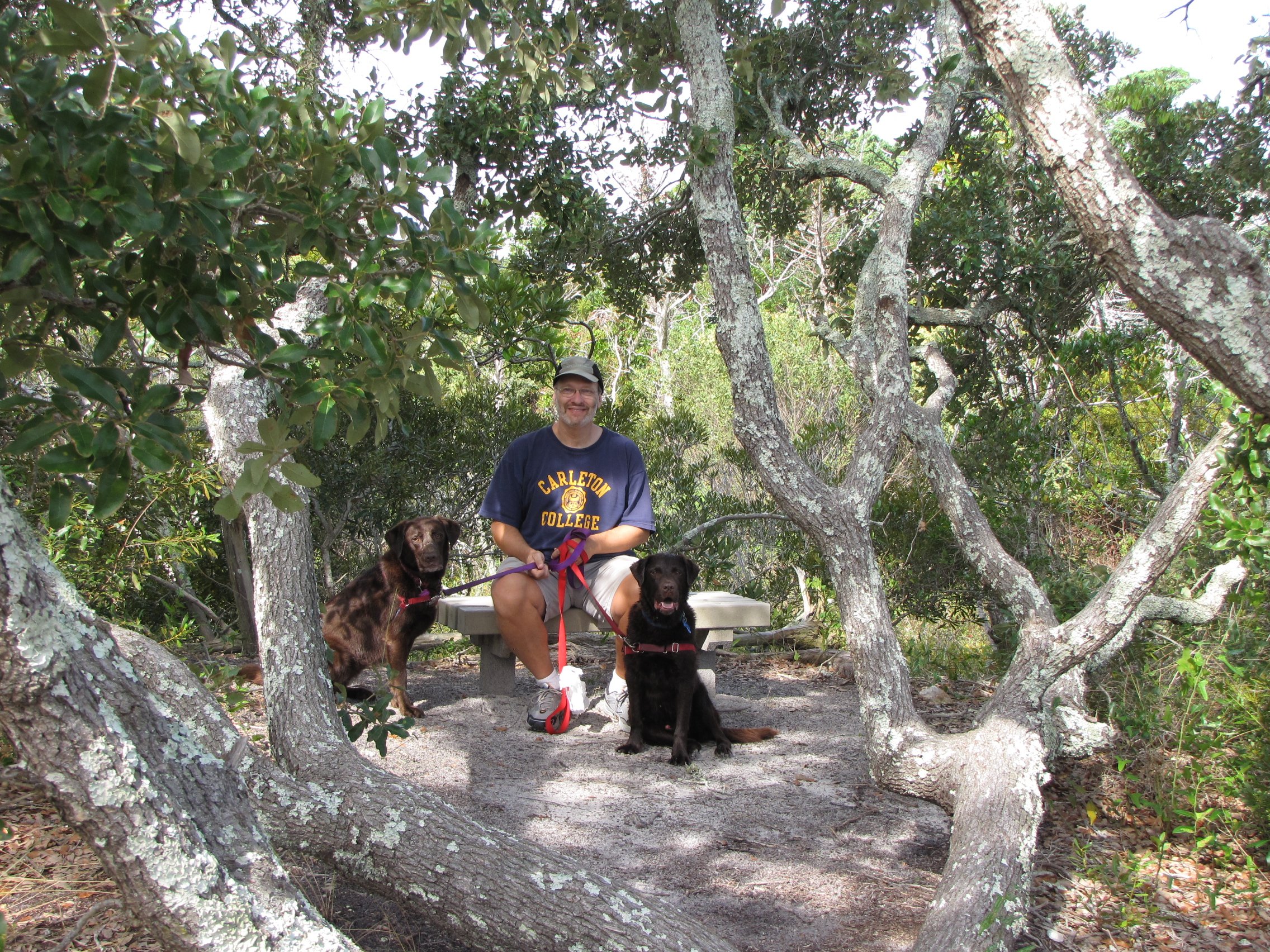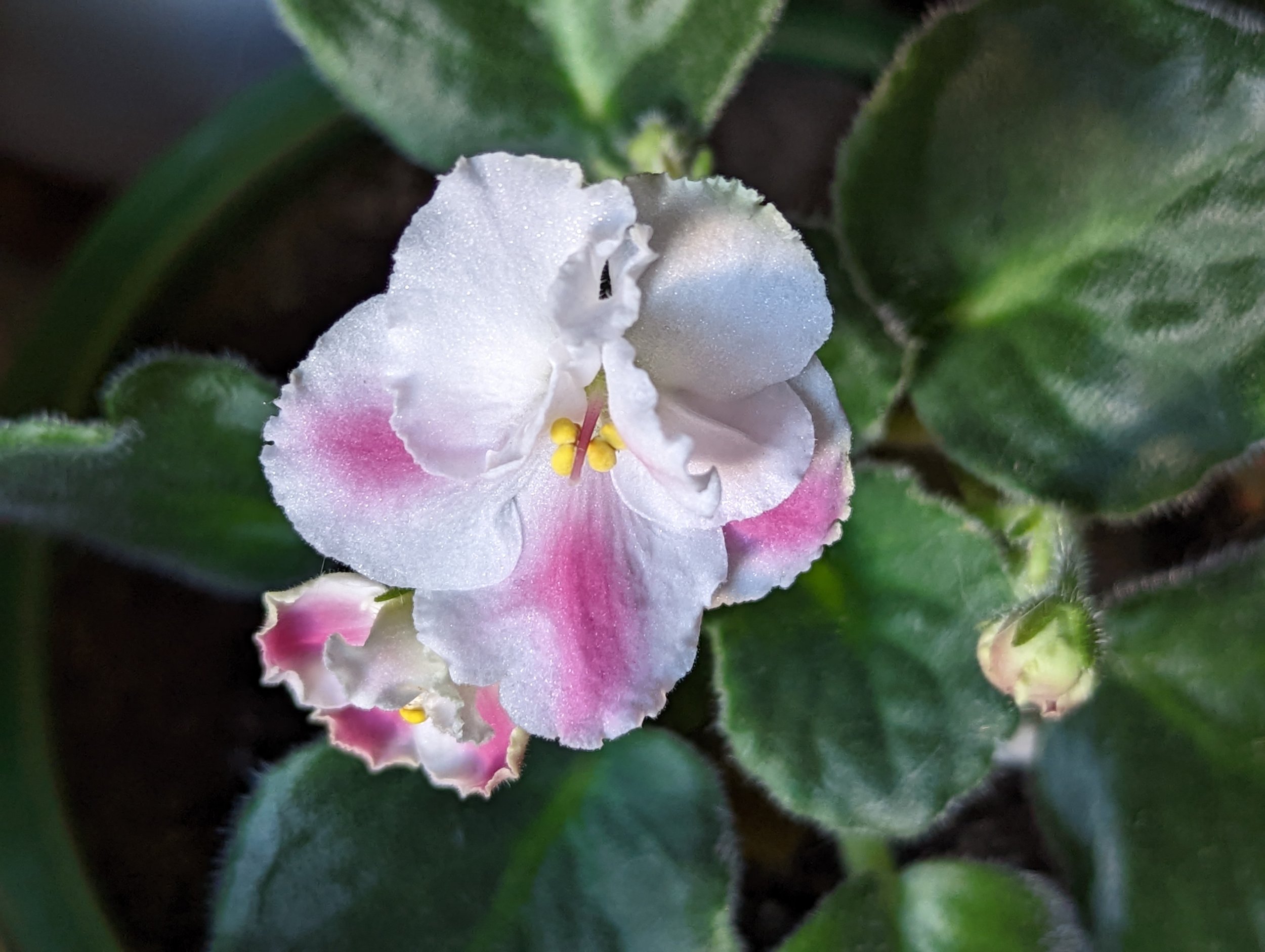Sue and Koda on a lovely chilly morning in DuPont - our last November hike for 2022 - on the Tarkiln and Tom’s Cemetary trails.
Here’s a nice long article by Carolyn - in fact, sadly, this is the last article written by her for Off The Vine, so enjoy. It captures her love of new creations, doing garden research, and saving and sharing seeds. After this, just three more articles to go. We will be done by Christmas for sure.
_______________________
Seed Sources and Free Seeds
Carolyn Male
I’d first line to mention that Craig and I are not a source of tomato seeds for Off The Vine subscribers. We both are active listed members of the Seed Savers Exchange SSE, see below), and participate in their seed activities, but do not feel it is appropriate for us to offer seeds for sale. I’m going to discuss both commercial sources and the special seeds we are offering through Off The Vine, but I’d first like to encourage all of you to consider membership in the SSE. SSE is not a commercial firm and is not a seed company. It is an organization dedicated to the preservation of heirloom vegetables, fruits and grains. If preserving our genetic heritage is important to you, you might wish to support SSE by becoming a member. Membership will give you access to about 3000 tomato varieties! Almost all of the varieties mentioned in OTV are available through the SSE. It is hoped that you would multiply seed obtained through SSE and reoffer it to others as a listed member although that certainly is not a requirement for membership. It’s pretty late in the season to obtain the current seed listings in the 1997 Yearbook, but by sending in $25 now, you might get it this Spring. It gets very busy at the SSE in the spring and there is usually a big backlog. They now publish a brochure which contains a few selected vegetable and flower varieties which are available to everyone, but the tomato offerings are limited. The address is Seed Savers Exchange, 3076 North Winn Road, Decorah, IA, 52101.
The following list of commercial sources is not inclusive; they are companies Craig and I, or others we know have dealt with and have been pleased with both the service and the seeds. The catalog ($2) of Southern Exposure Seed Exchange, PO Box 170, Earlysville, VA, 22936 is a treasure trove of heirloom histories and excellent open pollinated varieties. There is a large selection of heirloom tomatoes including many that have been mentioned in Off The Vine (too many to mention separately). Vince and Linda Sapp at Tomato Growers Supply have made a large commitment to heirloom tomatoes and now carry a superb collection. Again, many of the varieties have been mentioned here and are too numerous to mention individually. Their catalog is free and the address is Tomato Growers Supply Co., PO Box 2237, Fort Meyers, FL 33902. Rob Johnston of Johnny’s Selected Seeds has an excellent, but limited selection of heirloom tomatoes. Again, many have been mentioned here in OTV. The catalog is free and the address is Johnny’s Selected Seeds, Foss Hill Road, Albion ME, 04910. Tom Hauch has a small catalog which features many excellent heirloom tomatoes. The catalog is $1 and the address is Heirloom Seeds, PL Box 245, West Elizabeth, PA, 15088. Craig and I have been sending seeds for trial to the first three companies and we are pleased that they have selected some of our varieties to offer in their catalogs.
We are also making available to you a selection of 9 very special seeds, of which you may request any five varieties. These seeds are special because they are the result of either natural or deliberate cross pollination and the grow outs from some of these should be especially interesting. We need to discuss a little about tomato genetics before I describe the varieties.
The fruits which result from initial cross pollination (natural or deliberate) of two parents gives seed which is referred to as F1 seed (or F1 hybrid). When planted, all of the plants and fruit of F1 seed should be identical (but see the comments later about the Brandywine crosses). Seed isolated from the fruits of F1 plants is referred to as the F2 seed. When this seed is planted you’ll get a variety of different plants which might vary with respect to foliage type, fruit shape and color, earliness, etc. So if the F1 plants were potato leaf, for instance, the F2 plants may be regular leaf or potato leaf. And if the F1 fruit was red, you could get red, orange, or pink fruit, or whatever, in the F2s, depending on the parents. If you find an F2 plant that you like, save the seeds and plant again next year. These F3 seeds will also segregate out different characteristics so you’ll have to select again and grow out the next year to see the F4s. So how long does it take to genetically stabilize a variety? Well, how does 3-10 years sound? But really it is fun, and remember that every authentic family heirloom tomato was grown out and stabilized by someone until it came true every year! Some of the rejects are darn good and this stabilizing game really does start to grow on you. So if you have the room and the inclination, give it a try…I think you’ll love it!
The first series of seeds were hybridized by Stanley Zubrowski, an amateur Canadian hybridizer who has been trying to combine flavor (Brandywine) with a variety of early season varieties. All F1s are potato leaved and the fruit are about 4-6 ounces with a variety of fruit shapes and the color is red or pink (should all be red because Brandywine is pink and each of the four varieties it was crossed to are red; red is dominant to pink). These crosses are Brandywine X Stupice, Brandywine X Polish, Brandywine X Glacier, and Brandywine X Outdoor Girl. Seed offered is F2 seed. Tad Smith, author of our late blight article and a hybridization article in previous issues, is offering two crosses. The first is Yellow Oxheart X Ukrainian Heart (red). The F1 plants are wispy, as one often seeds with oxheart foliage and fruit are large pink hearts. Tad knows the Ukrainian Heart parent was red and is at a loss to explain the pink offspring. Seed offered is F2 seed. Tad’s other cross is Purple Perfect X Purple Price. These parents have the same coloration as Cherokee Purple, as do the F1 fruit. I happen to love Purple Perfect, the one parent, and several folks reported from last year that they got some excellent selections. Seed offered is the F2 seed, and seed amount is limited. I’m offering two crosses. The first is White Queen X unknown. White Queen is the best white I’ve ever grown, is oblate (flattened) with very good taste. The F1 fruit are large red and bomb shaped with excellent taste; could be some interesting ones that come out of this because I don’t know what the other parent is, other than it’s red. Seed offered is F2 seed. My other offering is OTV Brandywine, and this is a great tomato. The OTV reflects the fact that this cross originated in Craig’s garden between Yellow Brandywine and unknown, and I’ve stabilized it out to the F4, and now F5 generations. While pink, yellow and red/orange large beefsteak type fruit have appeared in the F2 and F3 generations, I’ve been selecting for the large red/orange potato leaf type and last summer all 8 plants were true. Seeds offered are either F4 or F5. OTV Brandywine is also being offered to members of SSE this year.
All of the above seeds were offered last year also, and I did receive some reports back from folks, and some reports were quite detailed, with color photos and seeds of the selections. I will share some of these reports with you in the next issue, but in general I’d say that everyone who contacted me praised OTV Brandywine very highly, found the range of fruit colors and shapes to be most extensive with the White Queen cross, like the Purple Perfect selections they got, and had varied comments about the Brandywine X “early red variety” crosses (my own impression is that the Brandywine X Stupice cross has the most potential). No one mentioned results with the Ukrainian Heart (red) X Yellow Oxheart cross, but we have no seeds to offer this year.
We have two new crosses to offer this year; both are from Steve Draper in Utah, and they are really interesting combinations. These are crosses Steve did himself. The first is Galina X Black Krim. Galina is a deep yellow cherry tomato with potato leaf foliage. Black Krim is one of the black/red types and is medium sized with a blackish red exterior and a brick/red/chocolate interior, and regular leaf foliage. Galina has just superb taste…Dr. Carolyn is an ivory mutant of it. Steve sent me his only four F1 seeds to grow out last summer. The plants are robust with regular leaf foliage and about 3-4 oz round fruit in clusters; the color is really deep red with darker undertones, and the taste is just superb! Considering the colors in this cross, the F2 growouts should be very interesting. Steve’s other cross is Banana Legs X Regina’s Yellow. Banana Legs is yellow and about 3-4 inches long by about 1 inch wide, and I don’t think anyone says its taste is outstanding. But Steve wanted to get some taste and color into it and so used Regina’s Yellow which is a large gold/red bicolor with vigorous regular leaf foliage; the taste of Regina’s is excellent, as is experienced with most bicolors. The F1 fruit in Steve’s garden was top shaped, the flesh soft like Banana Legs, and when fully ripe showed faint striping. Flavor was mild and all plants were vigorous like Regina’s, not scrawny like Banana Legs. Again, the F2 growouts should be very interesting. Seeds offered for both of Steve’s crosses are F2 seeds. There is plenty of seed of the first cross, but only enough for about 15 folks for the Banana Legs cross. Steve is moving from Utah to Washington State this month, and will not be able to grow as much in the Pacific NW. He hopes that you will let him know about his crosses because only through you can he find out what his efforts will have produced. I’ll post his address, perhaps, in the next issue of OTV.
These are experimental crosses. Please do not share them or list them with the SSE. The exception is OTV Brandywine, which already is listed with the SSE. You may select any five varieties; approximately 10 seeds of each variety will be sent out. Send your request to Patrick Millard, 1126 Justin Ridge Way, Waynesville, Ohio, 45068 and enclose a SASE with a 32 cent stamp; we would ask non-US folks to please enclose one dollar and not put stamps on the self addressed envelopes. Please do not send seed requests to either Craig or me, only to Pat, who has graciously agreed to once again send these seeds to you. Thanks so much, Pat, from all of us…we truly appreciate your time and efforts. I am writing this article on March 19, 1997; tomorrow I give the copy to Mike to do the layout. I should be able to send the laser copies to Craig next Tuesday. Hopefully he can send out the OTVs around Easter. That will still be enough time to request seeds and get them planted. Those of us in zones 4 and 5 can plant seeds up to mid-April and those of you in warmer zones have no problem because you have a longer growing season. I just know you’ll have lots of fun with these seeds. Remember, you may request five varieties, please enclose a SASE (US folks; envelopes with one dollar for non US folks) and send only to Pat Millard at the address above!
____________________
I never really kept up with the fate of the various crosses that Carolyn mentioned. It is hard to believe that these are from 1997 - 25 years ago!
Typical lazy afternoon array - Sue with Betts, Koda and Marlin having a nice snooze.

























